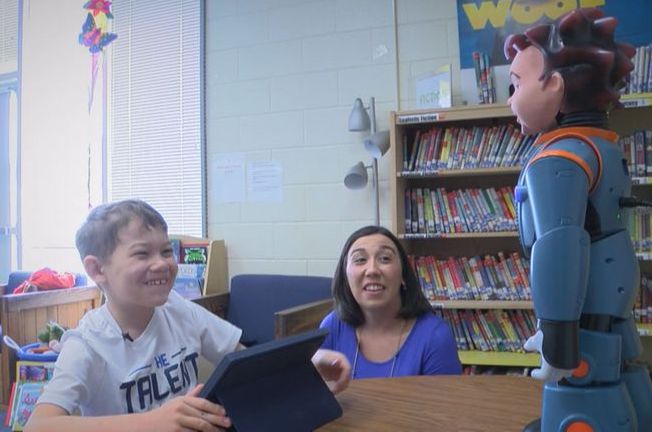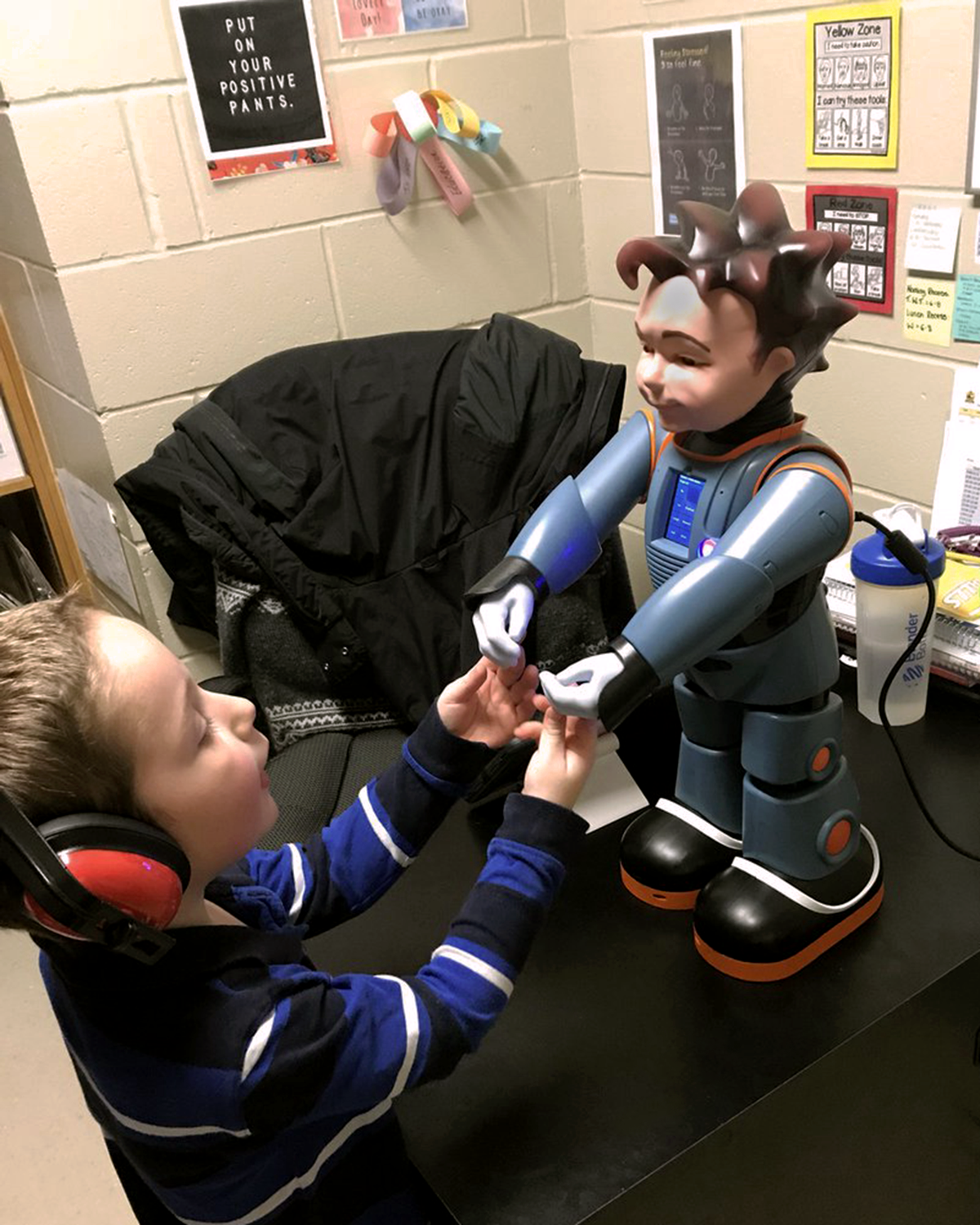The key to the effectiveness of any ed tech tool, including robots for children with autism, lies in whether students transfer the skills they’ve learned from schoolwork into their daily lives.
Educators at Stone Lakes Elementary School in Orlando, part of Orange County Public Schools, say this transfer is definitely occurring when students on the autism spectrum use a robot to develop social-emotional skills, such as calming themselves and greeting others appropriately.
“The students show a higher level of communication,” Principal Andronidus Rollins says. “We see relationships growing stronger in their interactions in the classroom, and especially when they interact with nondisabled peers in specials periods and at lunchtime.”
A range of autism robots—some lifelike, some cartoonlike spheres—also help special needs students learn core subjects and coding. The devices are highly effective because they provide students a safe space to experiment and near-instant feedback, educators and developers say.
“One advantage of coding and robots is that, especially with kids on the spectrum, it gives them the freedom to express what they’ve learned in a different way,” says Katie Caster, a K-5 STEM teacher at Oliver Hazard Perry School in Boston Public Schools. “That kind of authentic assessment is much more useful to me as a teacher.”
How robots for autism mimic emotions
At Stone Lakes Elementary, special education teacher Christy Dove convinced Principal Rollins to buy the Milo robot for autism after learning about it from a parent and deciding it could be a game changer in her classroom.
More from DA: How teacher coaching boosts special ed achievement
She has been using the robot, which looks like a little boy in a space suit, with a small group of third- through fifth-grade students over the past two years. Milo’s changing facial expressions allow Dove and her students to work on developing calming strategies, making eye contact and saying “hello,” and identifying the emotions of others.
“I am definitely seeing these kids take skills learned from the robot and generalize them into everyday situations,” she says.

Starting with calming techniques, Milo, developed by RoboKind, shows students how to stop and take a breath or squeeze a ball. That carries into daily life when students get upset and ask themselves, “What would Milo do?” Dove says.
Robots and special ed at FETC®
“Robotics in Special Ed: Encouraging Storytelling and Writing Across Curriculum” is just one of many special education sessions offered during DA’s National Future of Education Technology® Conference, Jan. 14-17 in Miami. To view the full agenda and register, visit www.fetc.org.
Children on the autism spectrum have difficulty determining how other people are feeling. Milo has dozens of facial expressions—his eyebrows move and his teeth chatter, for example—and his video camera can record students and show them on his video screen if they are responding appropriately.
“Students can mimic Milo’s emotions,” Dove says. “When he’s happy, they can get a feel for whether they look happy, too.”
Adding Milo required very little technology training, but Dove says she did have to adjust her lesson planning to integrate the robot for autism, which she typically uses with one student at a time so the robot can generate data on each child’s progress.
Richard Margolin, chief technology officer and founder of RoboKind, says one reason robots for autism are so effective at teaching social-emotional skills is that, unlike humans, the devices can repeat the same lessons without getting frustrated.
“That consistency and repetition is really important,” Margolin says. “It’s comfortable and it’s predictable, and Milo never gets impatient or angry. Milo never has a bad day.”

Teachers have reported that nonverbal students who have used Milo have begun communicating more effectively because in speaking to the robot, the children have seen that communicating makes life easier. This type of development allows students to spend more time in general education classes, which can save districts money.
More from DA: How to ensure safe travels for students with special needs
“In this way, special education classes become more like stepping stones because kids make progress and require fewer services,” Margolin says.
Coding the Big Bad Wolf
Few teaching tools captivate students as deeply as robots, says Caster, of Boston Public Schools. She uses the KIBO robot, by KinderLab Robotics, to teach lessons on math, animal life cycles and even fairy tales to students with autism, Down syndrome and other special needs.
KIBO, at first glance, could be mistaken for a toy that a child might use to learn shapes. But KIBO is all about programming and introducing children to computer science.
Children using KIBO place blocks with QR codes in a specific order, and then use a scanner to teach their program to the robot. They get to see if the robot follows their instructions.
For example, Caster’s students programmed KIBO to be the Big Bad Wolf. They recorded their voices saying “I’ll huff and I’ll puff,” and then built small houses out of different materials to test if the robot could run over them.
The activities transcend coding, math and language arts, and they help students develop key skills for problem-solving and creativity, following directions and staying on task, and working in a group and independently, Caster says.
“It brings all of those elements together to ensure there’s a variety of access points for each child,” she says.
Students who have trouble communicating and those who employ assistive devices to speak have also increased their use of language during and after their work with the robot. “They want to communicate,” Caster says. “They’ve become comfortable working in groups and are engaged enough to take risks.”
More from DA: Moving forward with college and careers in special education
KIBO was designed to combine the concrete, real-world elements of blocks and the abstract thinking required for coding, says Jason Innes, KinderLab’s manager of training and curriculum development. “Some kids on the spectrum really connect with the robot because they like the fact that their commands are carried out exactly and predictably,” Innes says.
Students on the spectrum can use the robot to communicate. Teachers, for example, can have students create a map of their neighborhood or town, and then each child can program a story about what they did the previous weekend by making the robot drive around map to the park, library or shopping mall.
“It also keeps students off screens and in the physical world,” Innes says. “Children are learning abstract concepts and skills, but they can see concrete effects in the classroom.”
Matt Zalaznick is senior writer







